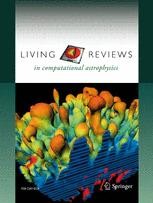Living Reviews in Computational Astrophysics: "Monte Carlo radiative transfer"
 Noebauer, U.M. & Sim, S.A., "Monte Carlo radiative transfer", Living Rev Comput Astrophys (2019) 5: 1. https://doi.org/10.1007/s41115-019-0004-9
Noebauer, U.M. & Sim, S.A., "Monte Carlo radiative transfer", Living Rev Comput Astrophys (2019) 5: 1. https://doi.org/10.1007/s41115-019-0004-9
Open Access | Review Article
First Online: 11 June 2019
Abstract:
The theory and numerical modelling of radiation processes and radiative transfer play a key role in astrophysics: they provide the link between the physical properties of an object and the radiation it emits. In the modern era of increasingly high-quality observational data and sophisticated physical theories, development and exploitation of a variety of approaches to the modelling of radiative transfer is needed. In this article, we focus on one remarkably versatile approach: Monte Carlo radiative transfer (MCRT). We describe the principles behind this approach, and highlight the relative ease with which they can (and have) been implemented for application to a range of astrophysical problems. All MCRT methods have in common a need to consider the adverse consequences of Monte Carlo noise in simulation results. We overview a range of methods used to suppress this noise and comment on their relative merits for a variety of applications. We conclude with a brief review of specific applications for which MCRT methods are currently popular and comment on the prospects for future developments.
Software collection
As part of this review, we freely distribute a number of MCRT Python programs used in the test calculations together with the configuration files for the Tardis simulation presented in Sect. 12. The interested reader can find all these in the GitHub repository at https://github.com/unoebauer/mcrtreview-tools.git.
